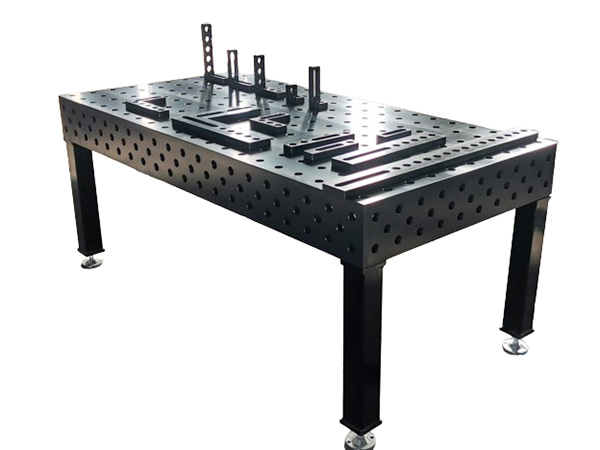- 网站导航 -
Address: Home > News > Technical documentation >
The design methods and techniques of welding tooling fixtures
Time:2024-06-05 10:51:08 Author:Fadetong Clicks:128Second-rate
Outline
I. Introduction
II. Basic Principles of Welding Tooling Fixture Design
III. Methods of Welding Tooling Fixture Design
IV. Positioning Design Method
V. Clamping Design Skills
VI. Structural Design of the Tooling Fixture
VII. Verification and Improvement of the Tooling Fixture
VIII. Conclusion

I. Introduction
In modern manufacturing industry, welding technology is widely applied in the connection of various metal materials with its characteristics of high efficiency and reliability. And the welding tooling fixture, as an indispensable tool in the welding process, its design quality is directly related to the accuracy, efficiency and safety of welding. This article will deeply explore the design methods and techniques of welding tooling fixtures to help the manufacturing industry achieve a higher level of welding production.
II. Basic Principles of Welding Tooling Fixture Design
(1) Principle of Positioning Accuracy
The primary task of the welding tooling fixture is to ensure the accurate positioning of the workpiece during the welding process. Through accurate positioning design, the welding error can be effectively reduced and the welding quality improved.
(2) Principle of Clamping Reliability
The clamping mechanism is the core part of the tooling fixture, and its reliability is directly related to the stability of the welding process. When designing, the distribution, transfer and adjustment of the clamping force should be fully considered to ensure that the workpiece does not move or deform during the welding process.
(3) Principle of Operational Convenience
The design of the tooling fixture should be convenient for the operator's quick installation, adjustment and disassembly. By optimizing the fixture structure and adopting convenient operation methods and other means, the welding production efficiency can be improved.
(4) Principle of Generality
In order to improve the application range of the tooling fixture, its generality should be considered when designing. Through modular design, standardized interfaces and other means, the quick matching between the fixture and workpieces of different specifications can be realized.
III. Methods of Welding Tooling Fixture Design
When designing the welding tooling fixture, first of all, it is necessary to deeply analyze the characteristics of the workpiece, including shape, size, weight, material, etc. According to the characteristics of the workpiece and the welding requirements, select the appropriate fixture type, such as mechanical fixture, magnetic fixture, vacuum fixture, etc. Next, according to the characteristics of the workpiece and the fixture type, design the structure of the fixture, including the clamping surface, positioning surface, supporting surface, etc. At the same time, according to the workpiece size and the welding accuracy requirements, determine the size and accuracy of the fixture. Finally, according to the use environment of the fixture and the material of the workpiece, select the appropriate material to ensure the durability and reliability of the fixture.
IV. Positioning Design Method
(1) Common Positioning Ways and Their Selection
In the design of welding tooling fixture, the selection of positioning way is crucial. Common positioning ways include mechanical positioning, pneumatic positioning, hydraulic positioning, etc. When designing, the appropriate positioning way should be selected according to the characteristics of the workpiece and the welding requirements.
(2) Design and Application of Positioning Elements
The positioning element is the key component to realize the accurate positioning of the workpiece. When designing, the shape, size, material and other factors of the positioning element should be fully considered to ensure that it can meet the requirements of positioning accuracy and clamping reliability.
(3) Control and Analysis of Positioning Error
The positioning error is one of the important factors affecting the welding quality. In the design process, the positioning error should be strictly controlled and analyzed, and the positioning error can be reduced by optimizing the design of the positioning element and improving the processing accuracy.
V. Clamping Design Skills
(1) Calculation and Determination of the Clamping Force
The magnitude of the clamping force directly affects the clamping effect of the workpiece and the stability of the welding process. When designing, the appropriate clamping force should be calculated and determined according to the material, shape and size of the workpiece.
(2) Types and Characteristics of the Clamping Mechanism
The clamping mechanism is the key component to realize the clamping of the workpiece. When designing, the appropriate clamping mechanism type should be selected according to the characteristics of the workpiece and the welding requirements, such as mechanical clamping, pneumatic clamping, hydraulic clamping, etc. At the same time, the stability, reliability and durability of the clamping mechanism should be fully considered.
(3) Optimized Design of the Clamping Device
In order to improve the efficiency and reliability of the clamping device, the optimized design should be carried out when designing. For example, the stability and reliability of the clamping device can be improved by improving the transmission way of the clamping mechanism and optimizing the distribution of the clamping force.
VI. Structural Design of the Tooling Fixture
(1) Construction Idea of the Overall Framework
The overall framework of the tooling fixture is the basis for supporting and connecting various components. When designing, a reasonable overall framework structure should be constructed according to the characteristics of the workpiece and the welding requirements.
(2) Connection and Cooperation of Each Component
The various components of the tooling fixture need to be closely coordinated to realize their functions. When designing, the connection way and cooperation accuracy between the various components should be fully considered to ensure the stability and reliability of the fixture.
(3) Consideration of the Stability and Strength of the Structure
The structural stability and strength of the tooling fixture are the basis for ensuring its normal operation. When designing, sufficient stability analysis and strength calculation should be carried out to ensure that the fixture can withstand various forces and moments during the welding process.
VII. Verification and Improvement of the Tooling Fixture
After the design is completed, the effect of the tooling fixture should be verified through actual welding. According to the verification results, the fixture is improved and optimized to improve its performance and reliability.
VIII. Conclusion
The design of the welding tooling fixture is an indispensable part in the welding production. Through reasonable design methods and techniques, the accurate positioning, reliable clamping and efficient operation of the fixture can be realized, thereby improving the welding quality and efficiency. In the actual design, the characteristics of the workpiece, the welding requirements and the operator's operating habits should be fully considered, and various factors should be comprehensively considered for optimized design.
If you want to know more information related to welding, welcome to contact us. Our company is a company that specializes in the production and sales of welding platforms and welding fixtures, and can provide you with more detailed product information!











